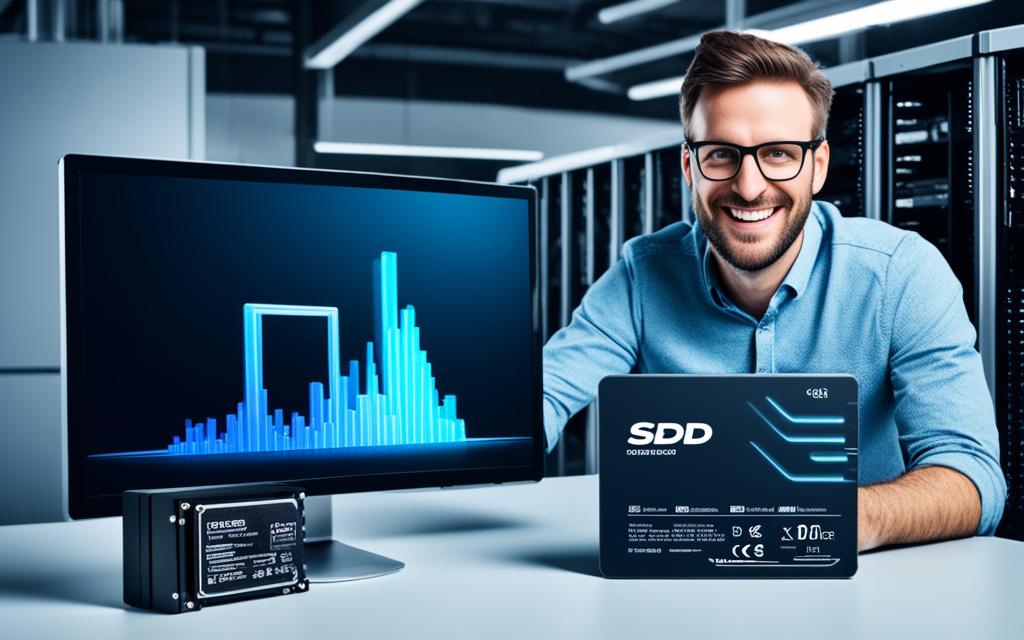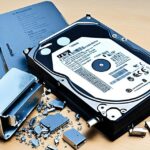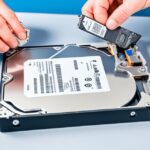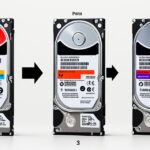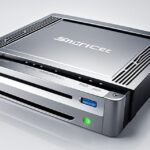Table of Contents
Switching from an HDD to an SSD is essential in today’s tech world. This swap boosts your system’s performance significantly. It makes your computer run faster and more efficiently. SSDs provide quicker data access speeds than HDDs. This means faster boot times and smoother daily operations. SSDs also use less power, which extends battery life in gadgets. They are quieter too because they have no moving parts. Starting your HDD to SSD migration is easy with this guide. It gives you the knowledge and tools for a hassle-free switch. Using tools like AOMEI Partition Assistant simplifies moving your data. This lets you enjoy the perks of your new SSD quickly123th>
Key Takeaways
- Ever-expanding benefits of SSDs include speed, durability, and efficiency.
- Be sure to back up your data prior to starting any migration process.
- Choose the right SSD that meets your specific needs for storage and performance.
- Different methods of transferring data include both cloning software and manual data transfer.
- Properly format your old HDD for enhanced performance as secondary storage.
- Implement optimisation tips for SSDs to maintain their performance and lifespan.
Why Upgrade to an SSD?
Switching to a solid-state drive (SSD) comes with many benefits that make your devices better. One key advantage of SSDs is their speed. They’re much faster than old hard disk drives (HDDs), making everything quick to load43. This speed-up means your computer will start faster and files move quicker.
Benefits of Solid State Drives
SSDs don’t just speed things up; they also use less power. This means laptops last longer on a single charge53. They’re robust and reliable because they don’t have moving parts. So, they’re less likely to break and lose your data43. Plus, they don’t make noise, offering a quieter workspace.
Comparative Performance Analysis: HDD vs. SSD
In a head-to-head of HDDs versus SSDs, SSDs win on speed. SATA SSDs can write up to 550 MB/s, while NVMe SSDs go up to an amazing 64,000 MB/s4. Studies show SSDs can be up to fifteen times faster than HDDs4. For gaming and opening apps, SSDs make a big difference in speed53. As prices drop, choosing SSDs for better storage performance becomes even easier.
Preparing for the Transfer
Moving data from a hard drive to an SSD needs careful planning. Do this to ensure a smooth change and keep your files safe. Having a good plan means backing up your data and picking the right SSD.
Back Up Your Data
Before moving any data, you should back it up well. Acronis, EaseUS Disk Copy, and EaseUS Partition Master are great for keeping your files safe on an external drive or in the cloud. These tools prevent losing any important information during the change.
Choosing the Right SSD for Your Needs
Choosing an SSD involves many factors. Start by figuring out how much storage you need; 500GB is a good start if you’re replacing a 128GB HDD. Brands like Samsung and Intel offer lots of options. Make sure the SSD works with your computer to avoid any problems that could affect its performance.
An SSD’s speed and reliability are better than a traditional HDD’s. This makes them a great choice for most people. Ensure the SSD you pick is better than your old HDD, especially if you plan to have more storage space.
How to Transfer Data from Hard Drive to SSD
Moving data from a hard drive to an SSD can greatly enhance performance. You can use SSD cloning software or manually transfer files. Each choice fits different needs.
Using Cloning Software
SSD cloning software, like AOMEI Backupper Professional or Macrium Reflect, makes copying data easy. It clones the whole hard drive to an SSD, including the system and apps. This keeps all settings. AOMEI even does cloning while you work, without stopping you. It supports many SSDs and operating systems. Its ease of use and strong features make it a great option6
Manual Data Transfer Methods
If cloning software isn’t for you, there’s manual transfer. This involves picking files and copying them to the SSD. It’s good for small data amounts but not big system files or apps. Before starting, back up your data for safety. Your choice between cloning and manual methods depends on how comfortable you are and how much data you have78.
| Feature | Cloning Software | Manual Transfer |
|---|---|---|
| Efficiency | High – transfers everything at once | Moderate – depends on user selection |
| Ease of Use | User-friendly interfaces with support | Requires more user knowledge |
| Data Integrity | Retains all original settings | Risk of overlooking files |
| Suitability for Large Transfers | Highly suitable | Less suitable/more cumbersome |
Choosing the best way to move data to an SSD is key. It ensures a smooth process and boosts SSD performance. Think about cloning versus manual transfer to decide what’s best for you.
Post-Transfer Steps
After installing your SSD, your computer will run faster. Now, it’s time to switch the old hard drive and prepare it for later use. Doing this properly is vital for your system’s future performance.
Swapping Drives Effectively
Begin by turning off your computer and unplugging it. Check the manual for help on how to get to the drives safely. Follow all safety tips to avoid any damage.
Remove the old HDD with care, making sure not to harm the connectors. Then, put the SSD in the right spot and plug everything back in. Make sure everything is in its place before you turn the computer back on. Now, make sure your data is safe from any threats during this change.
Formatting Your Old Hard Drive
With your SSD ready, you might want to use the old HDD for extra storage. This means formatting it, which deletes all the old data. To do this, you can use tools that come with your operating system.
You could also use software like MiniTool Partition Wizard. It helps with copying and moving data to make your drive ready for storage. Formatting gives your computer a fresh start, boosting its overall performance. To manage your files better, check out this guide for tips.
Conclusion
In today’s digital world, shifting from Hard Disk Drives (HDDs) to Solid State Drives (SSDs) is key. This shift boosts performance and enhances user experience. Key SSD benefits include quicker data transfers, lower power use, and more reliability. It’s no wonder many are moving to SSDs910. Following proper data migration methods ensures a smooth transition. It also keeps your data safe. The migration summary is a crucial tool in this change.
Using the right software, like AOMEI Partition Assistant Professional or 4DDiG Partition Manager, makes data transfer more efficient. It helps keep your data whole1110. Always back up crucial files before starting the migration. This ensures a hassle-free switch to an SSD. It avoids the issues often seen with HDDs.
Adopting SSDs updates your storage and improves your computer skills. Making this change means better productivity and performance in the long run. The initial effort in upgrading your storage will bring significant, lasting advantages for work and personal life.
FAQ
What are the primary benefits of upgrading to an SSD?
Getting an SSD boosts your computer significantly. It speeds up how fast it reads and writes data. This makes everything work faster, from starting up to running programs. SSDs also use less power, which saves energy. Unlike older hard drives, they’re tougher and less likely to get damaged.
How does the performance of SSDs compare to HDDs?
SSDs are way faster than HDDs in every speed test. They access data so quickly that your computer starts up in a flash. You’ll notice it most when opening files or starting programs. It makes using your computer a much smoother experience.
What should I do before migrating data to my new SSD?
It’s important to back up your files before you move them. You can use an external drive or cloud storage for this. This step keeps your data safe if something goes wrong. Tools like Acronis or EaseUS help, and so do the backup features on Windows and Mac.
How do I select the right SSD for my needs?
Picking the right SSD means looking at how much space you need and its speed. Make sure the new SSD is compatible with your system. You’ll want it to match or be better than your old hard drive, especially if you’re planning to store more data.
What is the process for using cloning software to transfer data to an SSD?
Cloning software like AOMEI or Macrium Reflect makes moving your data easy. First, you connect the new SSD. Then you choose the old hard drive as the source and start the clone. This keeps your operating system, apps, and settings just as they were, without reinstalling.
Are there manual methods for transferring data to an SSD?
Yes, you can manually copy and paste files to the SSD. This works well for smaller amounts of data. But, this method might not move everything perfectly, especially system files or programs.
What steps should I take when swapping my old HDD for a new SSD?
To switch to an SSD, first, turn off and unplug your computer. Then take out the old drive and put in the SSD. Be careful to avoid any damage. Also, remember to follow safety steps during the swap.
How can I format my old HDD after migrating to an SSD?
Once the SSD is in, you can format your old hard drive. Use disk management tools or software to do this. Formatting clears all the data and gets it ready for new use. It ensures your old drive can be safely used again.
Source Links
- https://www.diskpart.com/articles/how-to-transfer-data-from-hdd-to-ssd-7201.html – How to Transfer Data from HDD to SSD Drive in Windows 11/10/8/7?
- https://www.linkedin.com/advice/1/how-do-you-migrate-your-data-from-hdd – How do you migrate your data from an HDD to an SSD without losing quality or compatibility?
- https://www.easeus.com/pc-transfer/transfer-data-from-hdd-to-ssd-laptop.html – How to Transfer Data From HDD to SSD Laptop [2 Methods Available]
- https://www.kingston.com/en/blog/pc-performance/benefits-of-ssd – The 5 Benefits of SSDs over Hard Drives- Kingston Technology
- https://www.crucial.com/articles/about-ssd/how-to-upgrade-to-an-ssd – How to Upgrade to an SSD
- https://www.ubackup.com/articles/transfer-data-from-hdd-to-ssd.html – How to Transfer Data from HDD to SSD in Windows 10/11 (2 Ways)
- https://www.easeus.com/pc-transfer/move-files-from-hdd-to-ssd-windows-11.html – How to Move Files from HDD to SSD Windows 11 | 2 Solid Ways
- https://www.pcmag.com/how-to/copy-your-windows-installation-to-an-ssd – How to Copy Your Windows Installation to an SSD
- https://ipwithease.com/how-to-transfer-data-from-hdd-to-ssd/ – How to Transfer Data from HDD to SSD? – IP With Ease
- https://4ddig.tenorshare.com/hard-drive/how-to-transfer-c-drive-to-new-ssd.html – How to Transfer C Drive to New SSD? Step-By-Step Guide
- https://www.diskpart.com/articles/transfer-ssd-to-new-ssd-7201.html – How to Transfer SSD to New SSD Without Losing Data

